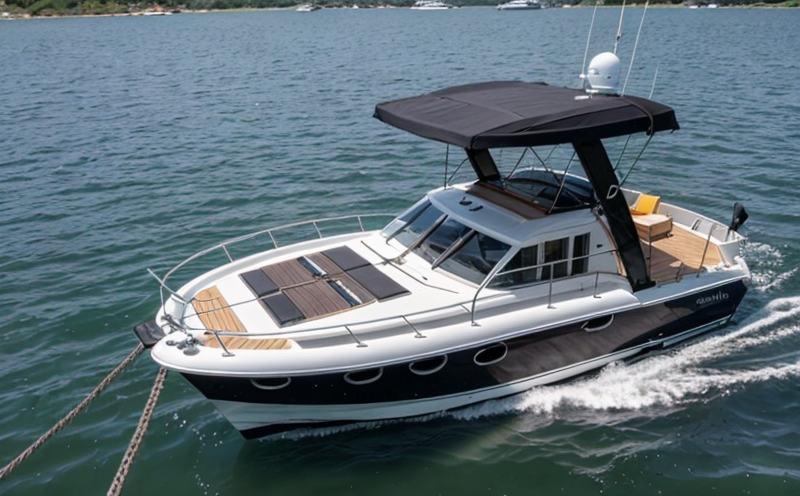ISO 1982 Anchor Shank Fatigue Testing
The ISO 1982 standard specifies a comprehensive procedure for determining the fatigue strength of anchor shanks. This testing method is crucial for ensuring the structural integrity and reliability of marine anchors, which are critical components in maritime operations. The test involves subjecting an anchor shank to cyclic loading until it either reaches a predetermined number of cycles or fails. Understanding this process requires a deep dive into its real-world implications and technical specifications.
The testing procedure is meticulously designed to replicate the dynamic loads encountered by anchors during deployment and retrieval in various marine environments. The primary objective is to evaluate the anchor shank's resistance to fatigue, which can be influenced by factors such as material type, manufacturing process, and environmental stressors like corrosion and temperature fluctuations.
For quality managers and compliance officers, this test ensures that manufacturers meet international standards and deliver products that can withstand harsh marine conditions. R&D engineers benefit from the insights gained into anchor shank performance under fatigue loading, which aids in material selection and design optimization. Procurement teams can verify that purchased components adhere to ISO 1982 guidelines.
The testing process typically begins with specimen preparation. The anchor shanks are carefully selected based on their size and shape, ensuring they represent the typical characteristics of production samples. Once prepared, the specimens undergo a series of preliminary inspections to confirm compliance with dimensional tolerances specified in the standard.
Following preparation, the specimens are mounted onto a fatigue testing machine equipped with fixtures capable of applying cyclic loads. The loading pattern simulates real-world conditions, including varying amplitudes and frequencies. Data collected during the test is analyzed using advanced software to track changes in material properties and potential failure mechanisms.
The results of ISO 1982 anchor shank fatigue testing are critical for several reasons. They provide manufacturers with valuable data on product performance, enabling continuous improvement through iterative design cycles. Compliance officers can use these results to ensure products meet regulatory requirements, thereby reducing the risk of non-compliance penalties. For R&D engineers, this testing method offers a platform to innovate and refine anchor designs.
Customer impact is significant as well. By ensuring that anchors are fatigue-tested according to ISO 1982 standards, shipyards and fleet operators can trust in the reliability of their equipment. This enhances operational safety and reduces maintenance costs associated with premature failures.
Applied Standards
| Standard | Description |
|---|---|
| ISO 1982-1:2015 | General requirements for anchor shanks and shackles - Part 1: Fatigue testing |
| ISO 1982-2:2015 | General requirements for anchor shanks and shackles - Part 2: Tensile strength testing |
The ISO standards provide a framework for ensuring that the fatigue tests conducted are consistent with international best practices. These include specific guidelines on specimen preparation, loading conditions, and data analysis.
Industry Applications
| Application | Description |
|---|---|
| Offshore Oil Platforms | Ensuring the durability of mooring anchors in harsh offshore conditions. |
| Cruise Ships | Evaluating anchor shanks for high-frequency deployment and retrieval cycles. |
| Fishing Vessels | Testing anchor shanks to withstand frequent use and environmental stressors. |
The application of ISO 1982 anchor shank fatigue testing extends beyond simple compliance. It plays a pivotal role in enhancing the operational efficiency and safety of maritime vessels by identifying potential weaknesses early in the product lifecycle.
Customer Impact and Satisfaction
The implementation of ISO 1982 anchor shank fatigue testing has a profound impact on customer satisfaction within the marine industry. By ensuring that anchors meet stringent fatigue resistance criteria, manufacturers can build trust with their customers who rely on reliable equipment for critical operations.
For shipyards and fleet operators, this translates into reduced downtime due to failed equipment and lower long-term costs associated with maintenance. The data generated from these tests provides a benchmark for performance, allowing stakeholders to make informed decisions about procurement and operational strategies.
Customer satisfaction is further enhanced through the transparency provided by ISO-compliant testing processes. This ensures that all parties involved in maritime operations have confidence in the quality of equipment they use.





